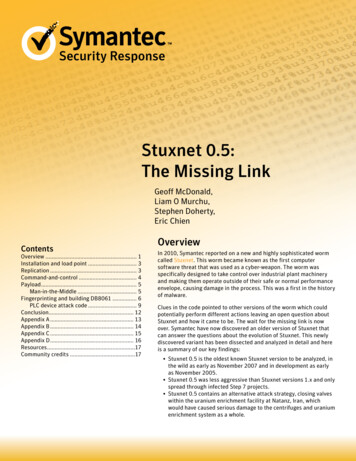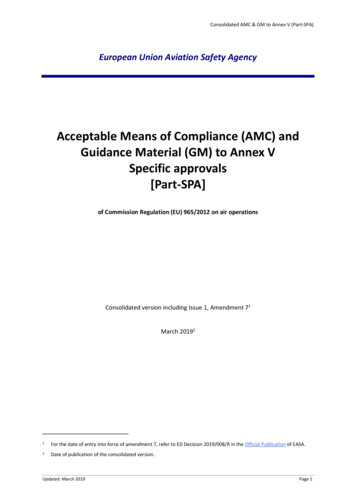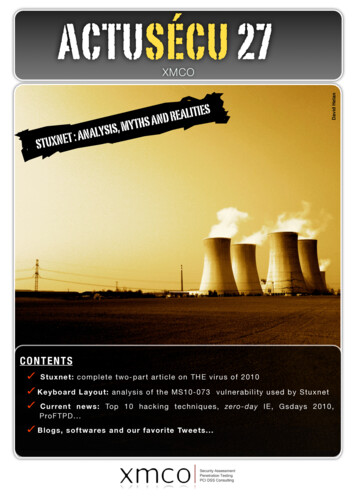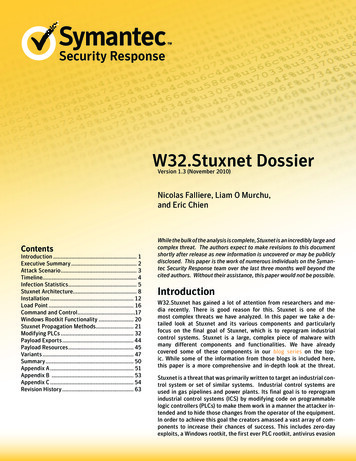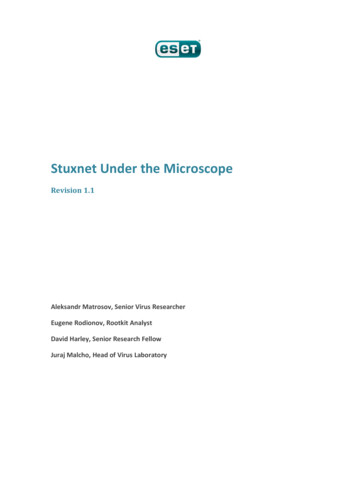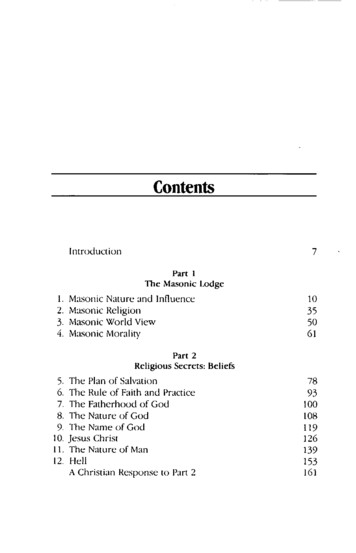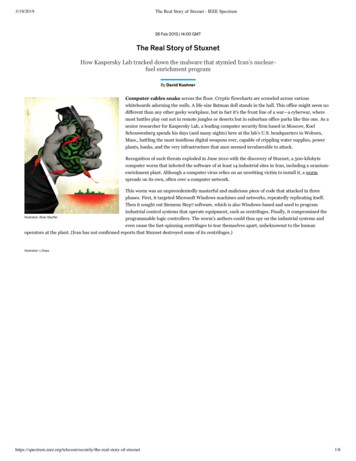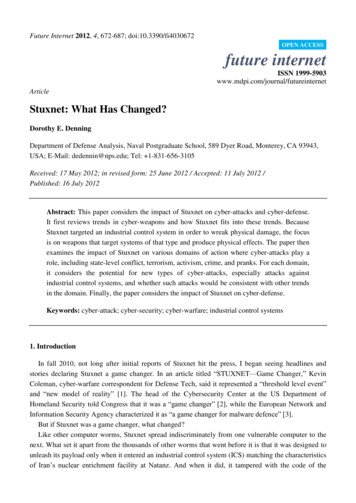
Transcription
Future Internet 2012, 4, 672-687; doi:10.3390/fi4030672OPEN ACCESSfuture internetISSN eStuxnet: What Has Changed?Dorothy E. DenningDepartment of Defense Analysis, Naval Postgraduate School, 589 Dyer Road, Monterey, CA 93943,USA; E-Mail: dedennin@nps.edu; Tel: 1-831-656-3105Received: 17 May 2012; in revised form: 25 June 2012 / Accepted: 11 July 2012 /Published: 16 July 2012Abstract: This paper considers the impact of Stuxnet on cyber-attacks and cyber-defense.It first reviews trends in cyber-weapons and how Stuxnet fits into these trends. BecauseStuxnet targeted an industrial control system in order to wreak physical damage, the focusis on weapons that target systems of that type and produce physical effects. The paper thenexamines the impact of Stuxnet on various domains of action where cyber-attacks play arole, including state-level conflict, terrorism, activism, crime, and pranks. For each domain,it considers the potential for new types of cyber-attacks, especially attacks againstindustrial control systems, and whether such attacks would be consistent with other trendsin the domain. Finally, the paper considers the impact of Stuxnet on cyber-defense.Keywords: cyber-attack; cyber-security; cyber-warfare; industrial control systems1. IntroductionIn fall 2010, not long after initial reports of Stuxnet hit the press, I began seeing headlines andstories declaring Stuxnet a game changer. In an article titled ―STUXNET—Game Changer,‖ KevinColeman, cyber-warfare correspondent for Defense Tech, said it represented a ―threshold level event‖and ―new model of reality‖ [1]. The head of the Cybersecurity Center at the US Department ofHomeland Security told Congress that it was a ―game changer‖ [2], while the European Network andInformation Security Agency characterized it as ―a game changer for malware defence‖ [3].But if Stuxnet was a game changer, what changed?Like other computer worms, Stuxnet spread indiscriminately from one vulnerable computer to thenext. What set it apart from the thousands of other worms that went before it is that it was designed tounleash its payload only when it entered an industrial control system (ICS) matching the characteristicsof Iran‘s nuclear enrichment facility at Natanz. And when it did, it tampered with the code of the
Future Internet 2012, 4673programmable logic controller (PLC) used to control the centrifuges at Natanz, ultimately destroyingabout a thousand centrifuges and disrupting Iran‘s nuclear program [4,5]. No previously reportedworm had done anything like that before, either in terms of precision targeting or causing physicaldamage through ICS manipulation.Is Stuxnet a forefather of future cyber-weapons? Will we soon see a rash of attacks against ICScomponents and devices, which include Supervisory Control and Data Acquisition (SCADA) systems,as well as PLCs? These systems are used, for instance, to operate electric power grids, distribute oiland gas, and control water treatment systems and dams. Are they adequately protected againstcyber-attacks? Will we witness cyber-attacks that go beyond the usual data theft and service disruptionin order to cause serious physical damage against specific targets? Will cyber-terrorists use Stuxnet-liketools to cause nuclear explosions, shut down power grids, blow up gas lines, cause floods, or otherwisewreak havoc?According to The New York Times, Stuxnet was developed and deployed by the United States andIsrael [5,6]. Does this mean that cyber-attacks have become an instrument of national power,augmenting other forms of national power, especially military power? Is Stuxnet a sign that cyber-warfareis already here or on the brink? Did Stuxnet‘s exposure and analysis bring cyber-warfare from theclosed world of spies and covert operations into the public sphere?This article addresses these and other questions in order to determine how Stuxnet has changed theongoing game of cyber-attack vs. cyber-defense. The approach is contextual, taking into account howStuxnet fits into or alters cyber-related trends.The paper first reviews trends in cyber-weapons. Because Stuxnet targeted an ICS in order to wreakphysical damage, focus is on weapons that manipulate systems of that type and produce physicaleffects. The paper then examines how Stuxnet impacts various domains of action where cyber-attacksplay a role, including state-level conflict, terrorism, activism, crime, and pranks. For each domain, itconsiders the potential for new types of cyber-attacks, especially attacks against an ICS, and whethersuch attacks would be consistent with other trends in the domain. Finally, the paper considers theeffect of Stuxnet on cyber-defense.2. Cyber-WeaponsTo appreciate the impact of Stuxnet on the development of destructive ICS cyber-weapons, it isnecessary to look at what ICS weapons had already been developed and deployed. If Stuxnet weremerely an incremental improvement over previous weapons, it would not qualify as a game changer inthis area.Prior to Stuxnet, the most sophisticated and damaging cyber-attack against an ICS was commonlyregarded as the months-long attack launched by Vitek Boden against the Maroochy Shire Councilsewerage control system in Queensland, Australia in 2000. A former employee of the contractingcompany that developed the system, the 48-year-old Australian used equipment and software he hadtaken from the company in order access the ICS network and alter data. His attack caused pumps tomalfunction and alarms to turn off, resulting in raw sewage overflows that killed marine life andharmed the environment [7].
Future Internet 2012, 4674While not to diminish the seriousness of Boden‘s attack, it was nonetheless considerably lesssophisticated than Stuxnet in at least three areas: access, command and control, and stealth. Withrespect to access, because the network controlling the centrifuges at Natanz was not remotelyaccessible or even connected to the Internet, Stuxnet was deployed in the form of a complex computerworm that spread across Microsoft Windows machines via USB memory sticks and local networklinks, exploiting several unknown (―zero-day‖) vulnerabilities in the systems it hit and using fraudulentdigital certificates to trick the systems into running its code [4]. As it spread, it had to examine thehardware, software, and settings of each system to determine if they matched those at Natanz,unleashing its payload only when they did. By contrast, Boden‘s equipment gave him immediate anddirect access to his target.Second, with respect to command and control, Stuxnet needed to operate autonomously, with itscommands and data wired into the code, although it also had the capability to receive new code overthe Internet if so connected. Boden, on the other hand, was able to issue commands directly from alaptop, without the need to preprogram his entire operation. Thus, while Stuxnet‘s authors needed toget it right the first time, Boden had the opportunity to try things out and adjust his tactics. Further,whereas much of Stuxnet‘s code had to be developed from scratch and carefully crafted so as torecognize its intended target, Boden was able to use code he had taken from the contracting companyand apply it directly against his target.Third, with respect to stealth, Stuxnet needed to conceal its presence long enough to cause thedesired damage. It did this by hiding its code and effects, leading network operators at Natanz tobelieve that the centrifuges were operating normally, even as they were being manipulated in harmfulways. Boden, by contrast, did little to hide his actions. Operators monitoring the network were awareof the problems he was causing, but initially did not know their source.There have been reports of cyber-attacks affecting other ICS devices, including those operatingelectric power grids, but I have not seen any information suggesting that any of these attacks was at thelevel of Stuxnet. At Idaho National Labs, researchers demonstrated how a cyber-attack could cause apower generator to self-destruct [8], but neither code nor details were released, making it difficult tocompare with Stuxnet. Nevertheless, it seems unlikely that the code would have been as complex asStuxnet, as it did not have to spread, recognize its target, or hide its presence and effects over anextended period of time. Thus, it seems reasonable to say that Stuxnet represented a considerableadvance over previous cyber-attacks or demonstrations against ICSs. As a cyber-weapon, it was amajor innovation.Still, for Stuxnet to be a game changer, it has to make a noticeable mark on the future. This mighthappen through two avenues. First, the authors of Stuxnet, seeing its success and having developedknowledge, skills, and tools for attacking a complex ICS, could build on their work in order to developand deploy new cyber-weapons against control systems. Indeed, this outcome seems likely. Stuxnetprovided not only a means of disrupting Iran‘s nuclear program, but an investment in the future andbuilding block for future cyber-attacks against ICS devices. Moreover, Stuxnet seems to be but one ofseveral tools developed by the United States and Israel. Another computer worm, nicknamed Flame,reportedly contains some of Stuxnet‘s code, although it was used to secretly map and monitor Iraniannetworks rather than cause damage [9]. A third worm, Duqu, which was also used for information
Future Internet 2012, 4675collection rather than sabotage, was said to be ―nearly identical to Stuxnet, but with a completelydifferent purpose‖ [10] and possibly built on the same platform [11].Second, observers of Stuxnet‘s success could be inspired to develop similar cyber-weapons of theirown. They might do this in order to attack a particular ICS device in support of a specific goal, orsimply to keep up with what they see is a ―cyber-arms race.‖ This avenue also seems likely, in partbecause humans are naturally competitive and inclined to borrow useful ideas and techniques fromothers, but also because Stuxnet is now ―out there‖—at least its object code is available. Although itssource code was not released, analysts have been able to decompile or reverse engineer the object codeto discern Stuxnet‘s functionality, making it easier to develop new cyber-attack tools against controlsystems. Code developers need not start from scratch.Besides studying Stuxnet, security researchers have been independently examining ICS security, theobjective being to identify vulnerabilities that could be exploited. Ideally, product manufacturerswould release patches (fixes) for the vulnerabilities, which customers would then install, rendering anycyber-weapons that attempted to exploit them ineffective. In practice, however, vulnerabilities are notalways fixed or patches installed, and exploit software is developed to take advantage of them.Researchers often develop these exploits to underscore the seriousness of the problem, push vendorsinto fixing them, and provide a mechanism for testing whether a particular system is vulnerable. Butonce published, the exploit code can also be used to facilitate harmful cyber-attacks.I started seeing reports of ICS vulnerabilities in 2007 and the release of exploits a few years later. InMarch 2011, the Moscow security firm Gleg announced the availability of Agora SCADA , a packagewith 22 exploits, including exploits for 11 ―zero-day‖ vulnerabilities. Six days later, securityresearcher Luigi Auriemma released proof-of-concept exploit code against 34 SCADA vulnerabilitiesin software from four vendors [12]. Then in January 2012, researchers released information describingsecurity flaws in widely-used PLCs from five vendors [13]. They provided exploit code for some ofthe flaws in the popular Metasploit framework, making it easier for security professionals to test theirsystems for the vulnerabilities—or their adversaries to attack them. Additional tools can be used tofind Internet-connected ICS devices, which might then be attacked. Using the Shodan search facility,for example, Éireann Leveritt found 7500 such devices. By fusing this data with exploit informationfrom Metasploit and ExploitDB plus geolocation data, he showed how someone could identify ICSdevices vulnerable to a cyber-attack [14].Software developers often build on the work of others, and this general principle applies to thedevelopment of cyber-attack code. Most viruses, worms, Trojans, and other types of malware are notdeveloped from scratch. Rather, existing code is modified and extended in order to produce a newversion that evades detection, takes advantage of new vulnerabilities, produces a different effect, uses adifferent command and control channel, or puts the author‘s personal touch on the code. Theemergence of cyber-weapons and exploits against ICS devices is thus likely to lead to the developmentof further cyber weapons against such targets, with Stuxnet offering one example. In this sense,Stuxnet might be regarded as just another data point on an ICS cyber-weapons curve that plotsweapons capabilities over time. However, it likely accelerated the curve‘s rise, as it is more complexthan other available ICS tools, and it drew considerable interest and study.If, as I have conjectured, Stuxnet influences the development of ICS cyber-weapons, how mightthose weapons be used? The next five sections each examine a domain of action where cyber-attacks
Future Internet 2012, 4676play a role: state-level conflict, terrorism, activism, crime, and pranks. For each domain, Stuxnet‘simpact is examined in the context of existing trends in the domain.3. State-Level Cyber ConflictAs already noted, Stuxnet was reportedly developed and deployed by the United States andIsrael [5,6]. The apparent objective was to do more than just destroy some centrifuges. It was to slowdown Iran‘s nuclear program. In that regard, Stuxnet achieved a national security goal that mightotherwise have been met with a kinetic attack such as bombing the Natanz facility. But it did sowithout killing or injuring anyone, destroying anything other than centrifuges, or risking the lives ofmilitary personnel delivering bombs. By causing less harm to its target and incurring less risk for itsperpetrators, it may have provided a morally better approach than its kinetic alternative, although itscollateral effect of infecting about a hundred thousand computers worldwide would also need to beconsidered. In any case, I am not arguing that the operation was ethical, only that it may have been amore ethical means of destroying centrifuges than bombs would have been [15].Only a handful of cyber-attacks have been publicly attributed to nation-states. In 1982, the UnitedStates is said to have planted a Trojan horse in Canadian software that was used by the Soviets tocontrol their Trans-Siberian gas pipeline. The effect was a massive explosion on a remote area of thepipeline [16]. Then in 2003, just before Operation Iraqi Freedom, the US penetrated the Iraqi DefenseMinistry e-mail system, injecting messages telling Iraqi officials that the US did not wish to harm themand asking them to not resist the coming invasion ([17], pp. 9–10).Israel is said to have used cyber-weapons to blind Syria‘s air defenses at the time of its airstrikeagainst a Syrian nuclear weapons facility in 2007. Nothing was damaged or destroyed, but the cyber-attackhad the effect of hiding the Israeli aircraft from Syrians who were monitoring their airspace ([17], pp. 1–8).Like Stuxnet, the cyber-attack offered a morally better choice than, say, a kinetic attack that physicallydamaged Syrian‘s air defenses.When at war, nations often launch destructive military strikes, including strikes against the criticalinfrastructures of their adversary. During the opening moments of Operation Desert Storm in 1991, aUS fighter plane directed a precision-guided bomb straight down the air-conditioning shaft of the Iraqitelephone system in downtown Bagdad, taking out the entire underground coaxial cable system and theprimary means of communicating between the Iraqi high command in Baghdad and subordinates in thefield [18]. What Stuxnet and the above instances of nation-state cyber-attacks illustrate is thepossibility of meeting national security objectives with bits rather than bombs. In so doing, operationsmay be less expensive, less deadly, less destructive, and less risky to their perpetrators. Instead ofdropping a bomb into a Baghdad communication facility, the US might have been able to temporarilydisable Iraqi military communications with a well-crafted cyber-weapon. Stuxnet showed just howsophisticated and precise such cyber-weapons can be. It was dramatically different from the weaponsused in the other instances, offering new possibilities for achieving military objectives.To the extent that cyber-weapons offer a less costly but morally preferred means of achievingnational objectives over kinetic strikes, nation-states may find them an attractive alternative. Cyberweapons might be used to disrupt activity at other facilities believed to be involved in the productionof weapons of mass destruction. During military operations, they might be deployed to temporarily
Future Internet 2012, 4677disable power, communications, transportation, or other services, allowing the rapid restoration of suchservices once hostilities end, and thereby avoiding the costs and problems associated with post-conflictreconstruction. Stuxnet showed what is possible against an ICS, while providing a blueprint for attacksagainst nuclear enrichment facilities. Of course, just because a cyber-weapon employs bits rather thanbombs does not mean that it cannot cause serious damage, including deadly explosions. In determiningwhether a particular cyber-weapon offers a moral advantage over a kinetic one, all effects mustbe considered.Although reports of state-level cyber-attacks have been few and far between, states are frequentlyaccused of penetrating each other‘s networks in order to steal government and commercial secrets.State-level espionage has always been considered fair game, even during peacetime, and cyberspacehas proven to be an easy and effective means for collecting information. China alone has been blamedfor numerous instances of snooping against US and international targets since 2003, includingincidents dubbed Titan Rain, Byzantine Hades, GhostNet, Shadows, Aurora, Night Dragon, ShadyRAT, and Nitro. According to US intelligence agencies, most of the spying from China traces back togroups associated with China‘s People‘s Liberation Army [19]. Even earlier, Russia reportedly stoleinformation from US Department of Defense networks beginning in the late 1990s in an incidentnamed Moonlight Maze.Although cyber-espionage is not the same as cyber-attack, their technologies are not all thatdifferent, as both require mechanisms to penetrate systems, access information, control operations, andconceal activity and effects. Thus, any country with a cyber-espionage capability is likely to also havea cyber-attack capability. According to Admiral Mike McConnell, former Director of NationalIntelligence, most industrialized countries in the world today have these capabilities, at least to somedegree. Other intelligence officials have suggested that the number of militaries with a ―respectablecyber war capability‖ is around twenty to thirty. Besides those I have already mentioned in this article,namely the US, Israel, China, and Russia, the list includes Taiwan, Iran, Australia, South Korea, India,Pakistan, and several NATO states, to include France [17, p. 64].Whether Stuxnet has affected these cyber-warfare capabilities is hard to say. Governments had beendeveloping them independent of Stuxnet. Still, Stuxnet represented an advanced cyber-attack againstthe ICS of another state. Given its exposure, it may influence the types of cyber-weapons that statesdevelop and accelerate a state-level cyber-arms race. It is not surprising that Iran was reportedlyinvesting 1 billion to boost its offensive and defensive cyber-warfare capabilities after it had been hitby Stuxnet [20].Stuxnet is frequently mentioned in academic and policy discussions about cyber-warfare andsecurity, at both domestic and international levels. It that regard, it may have helped bring cyber-warfarefrom ―the shadows of the clandestine world into the limelight,‖ as Coleman opined [1]. Althoughcyber-warfare had been the subject of discussion well-before the Stuxnet attack, Stuxnet provided anactual incident, allowing the discussions to move beyond the hypothetical scenarios normallyemployed to a concrete example that had been experienced and documented. In so doing, it could helpadvance our understanding of how the law of armed conflict (LOAC) applies to cyberspace. Whilesome might argue that Stuxnet represents a ―use of force‖ in violation of Article 2(4) of the UnitedNations Charter, others might view Stuxnet as something less than force or as a reasonable use of forceagainst the threat posed by Iran‘s nuclear program under Article 51. For those in the latter camp,
Future Internet 2012, 4678Stuxnet becomes not only permissible under LOAC, but morally preferred over a kinetic strike, at leastif its collateral effects are ignored. By providing a specific cyber-weapon and context for itsdeployment, Stuxnet lets us not only examine the application of LOAC, but also see how a cyber-attackcan potentially offer a kinder and gentler means of achieving a just objective than through theapplication of traditional force.4. Cyber-TerrorismI have been writing about the prospects of cyber-terrorism since the late 1990s, always coming tothe conclusion that it was not yet here, but leaving open the possibility that we would see it in thefuture and acknowledging that cyber-threats overall were serious, growing, and in need of beingaddressed. In my most recent article, a follow-up to one I had written right after al-Qaeda‘s11 September 2001 terrorist attacks, I wrote: ―Thus, the decade following 9.11 closes in much the samestate as it began. Al-Qaeda and other terrorist groups still prefer bombs to bytes, and cyber terrorismremains a hypothetical threat even as the overall threat level in cyberspace has increased‖ [21].This does not mean that terrorists and jihadists aligning themselves with al-Qaeda have neverconducted a cyber-attack. Indeed, they have defaced and conducted low-level denial-of-service (DOS)attacks against websites they believe are harmful to Islam. But none of these attacks has risen to thelevel of cyber-terrorism. For a politically-motivated cyber-attack to be considered an act of cyber-terror, itwould have to be serious enough to actually incite terror on a par with violent, physical acts ofterrorism such as bombings. Attacks that caused major blackouts, gas pipeline explosions, trainderailments, plane crashes, large financial losses, and the like would fall in that category. Attacks thatmerely disrupt access to a public website do not.In another paper, I offered three indictors that might precede a successful incident ofcyber-terrorism [22]: Failed cyber-attacks against critical infrastructures, particularly the ICS devices that are used tomonitor and control these infrastructures. I thought it unlikely that a first attempt wouldsucceed with the desired effect, given the novelty of such an attack and uncertainty about howit would play out. Stuxnet might be considered an exception to this, but terrorists would nothave the capabilities and resources of nation-states such as Israel and the United States, andthus more difficulty getting it right the first time. Even their kinetic attacks frequently fail.Research and training labs, where terrorists simulate the effects of cyber-attacks against criticalinfrastructures, develop methods and tools to attack ICSs, and train people on how to conductsuch attacks. I reasoned that it is hard to perform controlled experiments and analyze theconsequences without a lab, as Israel appeared to have had for Stuxnet at their Dimonacomplex. Absent special facilities, I expected to at least see training materials showingterrorists how to conduct damaging attacks against ICSs and software tools designed tofacilitate such attacks.Extensive discussions and planning relating to acts of cyber-terror against criticalinfrastructures, not just attacks against websites and attacks aimed at making money.
Future Internet 2012, 4679When Stuxnet came along, at least one jihadist took notice. A posting to the popular al-Shamukhjihadist forum in late 2010 called for attacks against SCADA systems, claiming they could be used tocause a massive explosion in a power plant, even a nuclear one, among other things. However, whilegiving a broad overview of SCADA systems and pointing to Stuxnet, the Australian sewage overflows,and other incidents affecting critical infrastructures, the posting offered no details for executing suchattacks. Further, the premier jihadist English-language publication, Inspire, which has published nineissues as of May 2012, has focused exclusively on physical acts of violence. Readers can learn how to―make a bomb in the kitchen of your mom,‖ but not how to conduct even rudimentary cyber-attacks.Although jihadist websites and forums have offered tutorials and tools for rudimentary hacking, Ihave not seen jihadist materials for specifically attacking an ICS or any information suggesting thatjihadists have access to a lab with ICS equipment and software, or that they have even attemptedcyber-attacks against an ICS. The existence of Stuxnet, recognition of the potential damage thatcyber-weapons such as Stuxnet could cause, and the availability of exploit tools against ICSs maybring us a bit closer to a cyber-terrorist incident than we were before Stuxnet, but the threat does notseem imminent.5. Cyber-ActivismCyber-activism refers to the use of cyberspace to promote some cause. It includes the developmentand use of cyber-tools that that support online actions such as e-petitions and e-mail writing campaigns,facilitate the organization and coordination of offline activities such as street demonstrations andmarches, and help persons evade government censorship and surveillance while using the Internet. Italso includes the development and use of cyber-attack tools for protesting the actions of governmentsand corporations. Cyber-activism is sometimes referred to as hacktivism, as it lies at the intersection ofhacking (writing software or conducting cyber-attacks) and activism. While most cyber-activists wouldhave no interest in a destructive tool like Stuxnet, a few might find it of value.To the best of my knowledge, no hacktivist group has conducted a cyber-attack against an ICS.Rather, those who deploy cyber-attacks have resorted primarily to web defacements and DOS attacks.They either post their grievances and demands on the hacked websites of their opponents, or else theybombard the sites with so much network traffic that legitimate access to the sites becomes difficult toimpossible. The cyber-attacks launched by patriotic Russian hackers against Estonia in 2007 and Georgiain 2008 illustrate [17, pp. 11–21], as do many of those conducted by the collective named Anonymous.Some hacktivists have gone beyond web defacements and DOS attacks, however, compromisingand disclosing sensitive documents, e-mails, and personal data, including passwords and credit cardnumbers. For example Anonymous, together with various groups linked to it such as LulzSec, hasexposed the poorly secured systems of numerous agencies and corporations, and in so doing releasedsensitive, embarrassing, and personal information. They have put people at risk of identity theft, fraud,and other criminal acts. They also threatened a DOS attack against the Internet‘s root name servers,although the attack either did not take place or else had no noticeable effect [23]. According to theNational Cybersecurity and Communications Integration Center (NCCIC), Anonymous has expressedan interest in targeting ICSs, but they have not yet demonstrated a capability to inflict damage onsuch systems [24].
Future Internet 2012, 4680Given the apparent interest of Anonymous (and perhaps other hacktivists), the possibility ofhacktivists targeting an ICS cannot be ruled out. Further, a survey of 353 students at a Midwesternuniversity in the United States found that a small percentage would be willing to conduct a cyber-attackthat compromised a regional electric power grid, causing a temporary blackout, or a nuclear powerplant, causing a release of radioactivity. In particular, 1.68% said they thought it would be appropriateto compromise a regional grid in their own country if their government engaged in harmful and unjustactivities, while 3.08% said they would be willing to attack a grid in a foreign country that had harmedtheir homeland. A smaller percentage said they thought it would be appropriate to compromise anuclear power plant, with 0.84% willing to attack one in their own country and 0.28% willing to attackone in a foreign country. A much larger percentage supported defacing a politician‘s or governmentwebsite in their homeland (25.21%) or foreign country (22.40%), and still larger percentage supportedposting something on Facebook (77.31% and 76.19%) [25].In addition to attacking an ICS to protest the actions of one‘s own or a foreign government,hacktivists might attack an ICS in order to protest the nature of the facilities using the ICS. A groupopposed to the continued use of fossil fuels, for example, might conduct a cyber-attack against an ICSin order to temporarily disrupt the processing or distribution of such fuels. If hacktivists do target ICSs,then Stuxnet, together with other ICS-related exploit tools, might prove to be a game changer in thisdomain. Still, most hacktivists could stay clear of ICS attacks out o
the details of the two bills vary, so Stuxnet—along with all the other cyber-security threats that occurred in the interim—may have had some impact on the 2012 bill. Even if Stuxnet has had little impact on the strategic direction of the US government's cyber-security program, it has impacted day-to-day operations.
